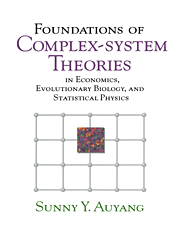Book contents
- Frontmatter
- Contents
- Preface
- 1 Introduction
- PART I EQUILIBRIUM
- 2 Theories of Composite Systems
- 3 Individuals: Constituents and Systems
- 4 Situated Individuals and the Situation
- 5 Interacting Individuals and Collective Phenomena
- 6 Composite Individuals and Emergent Characters
- PART II DYNAMICS
- Notes
- Bibliography
- Name Index
- Subject Index
4 - Situated Individuals and the Situation
Published online by Cambridge University Press: 11 May 2010
- Frontmatter
- Contents
- Preface
- 1 Introduction
- PART I EQUILIBRIUM
- 2 Theories of Composite Systems
- 3 Individuals: Constituents and Systems
- 4 Situated Individuals and the Situation
- 5 Interacting Individuals and Collective Phenomena
- 6 Composite Individuals and Emergent Characters
- PART II DYNAMICS
- Notes
- Bibliography
- Name Index
- Subject Index
Summary
Independent-individual Approximations
The intuitive formulation of a many-body problem is an extrapolation from a few-body problem. We take the familiar character types and relation types of the constituents as they are known from small systems, then add more constituents. Therefore the only difference between small and large systems is the number of constituents, as the character and relation types are common to all. The basic formulation provides a unified view of the world and conveys the idea that exotic systems are made up of ordinary parts related in ordinary ways. Unfortunately, it soon leads to a technical impasse. An n-body problem for n = 1010 cannot be solved by extrapolating concepts and methods suitable to n = 2, not if the bodies interact. To make headway and get concrete results, we need to recast the problem of large-scale composition into a more tractable form. Fortunately, the theoretical framework in terms of system state spaces presented in the preceding chapter has already enabled us to grasp complex systems as wholes. Now we turn to finding more substantive formulations within the synthetic framework to microanalyze the systems.
Perhaps the most common and successful strategy of microanalysis is modularization, which draws on the insight that the whole is the sum of its parts. The saying is wrong generally; it is valid only if the parts are unrelated, and a heap of disjoint parts is hardly worthy of the epithet “whole.”
- Type
- Chapter
- Information
- Foundations of Complex-system TheoriesIn Economics, Evolutionary Biology, and Statistical Physics, pp. 115 - 150Publisher: Cambridge University PressPrint publication year: 1998



